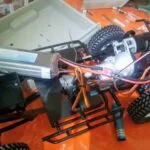What does “S”\”P” mean on a LiPo battery (Explained)
A LiPo or lithium-ion polymer battery is a rechargeable battery formed by a polymer electrolyte. A LiPo battery has a rectangular or cylindrical shape. A LiPo battery pack is made up of two or more LiPo cells. These cells are like smaller batteries inside the pack. Each cell is rated at a nominal voltage of 3.7 volts.
On a LiPo battery, S means ‘Series’ and P means ‘Parallel’. These two are used together to get a larger capacity battery pack with higher voltage.
A Battery pack has several connecting cells in series and each of them adds to the total terminal voltage. A 3S2P battery pack means that there are 3 cells in series and 2 cells in parallel. Likewise, 2S1P means 2 cells in series and 1 cell in parallel. If a battery does not have a ‘P’ then it is assumed to be ‘1P’. That is, 1P and a plain P mean the same thing.
LiPo batteries have higher energy and discharge current when compared to other types of batteries. They are used in applications that have heavy weight and require high-performance such as toys, drones, RC vehicles and some mobile phones. When fully charged, a standard LiPo cell has 4.2 volts. Multiple cells can be put together in series to raise the voltage.
What does ‘S’ represent in RC LiPo batteries?
The “S” on a LiPo battery means series. It is the number of cells in a series. If you have a 2S battery, it means there are 2 cells in series.
Counting the number of wires in the balance connector tells you how many cells are in a LiPo battery. If the balance connector has 3 wires, it is a 2S LiPo battery. If the balance connector has 5 wires, it is a 4S LiPo battery.
What does a 6s battery mean?
A 6s battery means there are 6 cells in series. Each LiPo cell has 3.7 volts. So, a 6S LiPo means it’s a 6 cell battery and has 22.2v (3.7v x 6).
A fully charged 6s battery can last for 30-40 minutes depending on how hard you drive it, as well as the conditions you drive it in.
What does a 5s battery mean?
Each LiPo cell has 3.7 volts. So, a 5S LiPo means it’s a 5 cell battery and has 18.5v (3.7v x 5).
What does a 4s battery mean?
A LiPo cell has a nominal voltage of 3.7V. A 4S battery means there are 4 cells in series and it has 14.8v (3.7v x 4).
What does a 3s battery mean?
A 3S battery means there are 3 cells connected in series and it has 11.1v (3.7v x 3).
What does a 2s battery mean?
A 2S battery has two cells connected in series and is 7.4V.
What does ‘P’ represent in RC LiPo batteries?
The ‘P’ on a LiPo battery means ‘parallel’. It is the number of batteries in parallel. If you have a 3P2S battery, it means there are 3 cells in parallel.
Voltage chart
The higher the series (S), the higher the voltage (V) of the battery and the faster it charges.
For example, a two-cell battery (2S) is 3.7V x 2 =7.4V, three-cell (3S) is 3.7V x 3 = 11.1V, and it goes like that.
A dead LiPo battery cell has 3.3 volts. When fully charged, a standard LiPo cell has 4.2 volts. Multiple cells can be put together in series to raise the voltage.
VOLTAGE CHART
CAPACITY | 1 S | 2 S | 3 S | 4 S | NOTE |
| 100% | 4.2V | 8.4V | 12.6V | 16.8V | Full |
| 80% | 3.9V | 7.8V | 11.7V | 15.6V | Cold Charge |
| 60% | 3.85V | 7.7V | 11.55V | 15.4V | Storage |
| 50% | 3.82V | 7.6V | 11.46V | 15.28V | |
| 40% | 3.75V | 7.5V | 11.25V | 15V | Long Term Storage |
| 20% | 3.70V | 7.4V | 11.1V | 14.8V | Nominal Voltage |
| 10% | 3.68V | 7.35V | 11.04V | 14.7V | Rapid Voltage |
| <10% | 3.65V | 7.3V | 10.95V | 14.6V | Very Low |
What are the cells in a LiPo battery?
A LiPo is a battery that has one or more elements consisting of Lithium-Polymer cells. The cells in a LiPo battery are formed by polymer electrolytes. ‘S’ represents ‘cells in series’ while ‘P’ represents ‘cells in parallel’.
The LiPo gives high energy and current discharge. It also has a relatively low weight. The balance connector allows access for monitoring and charging of the cells so that all cells can be equally charged. You can find out the number of cells in a LiPo battery by counting the wires in the balance collector.
Why should you get a bigger ’S’ battery?
LiPo batteries do not expire but they can begin to give low performance after excessive use or a time period. This can require getting a new or better battery.
Generally, the larger the battery, the more capacity it has for energy storage. So, getting a bigger battery helps you store more energy and make your vehicle move faster.
When you compare a big and small battery of the same rate of 1.5V, the big battery stores more energy and provides a longer battery life.
Will you notice the difference between each battery pack?
Yes, there will be an obvious difference if you connect two different batteries because the highest voltage will try to charge the lower voltage. This difference in voltage can cause a battery failure.
Will a difference in battery packs make your RC faster?
Yes, changing your batteries can enhance your RC car’s performance.
If you’ve been using a NiMh battery, changing it to a LiPo will make a lot of difference as LiPo batteries have higher energy and higher discharge capacity. And, if you’ve been using a 2S LiPo battery, you can upgrade to a 3S for more speed and power.
Will a difference in battery packs make your RC run longer?
mAh refers to the capacity of a battery in milliamp hours. A milliamp is 1/1000. A 6000mAh battery will hold a 6 amp load for an hour. The greater the number of mAh, the longer time your car will run. So, getting a battery with more capacity means your car can run for a longer time.
Battery packs for various types of RC cars
For now, there are four types of battery packs for RC cars.
1. Stick Battery Pack: It has a length of 139mm, height of 25mm and width of 46mm. It is used in 2wd buggys and short course trucks.
2. Saddle Battery Pack: A saddle is half the length of a stick pack and can be put side by side to form a square. 4wd buggys and short course trucks use this type of battery.
3. Shorty Battery Pack: Shorty packs are shorter stick packs. They are less than 100mm long and are light. They are good for off-road cars.
4. Block Battery Pack: This is a new type of pack modified from the others which has three batteries in two different cases.
Read about the best batteries for remote-controlled vehicles
Can you make your own LiPo battery packs?
Absolutely! You can build your own LiPo battery pack from old or new cells using the right tools.
New LiPo batteries can be expensive and still not be exactly what you need. Making your own battery packs can be fun and fulfilling. But you need to have a guideline to follow to avoid causing a fire or damage to your RC vehicle.
How to make your own LiPo battery packs
Lithium polymer batteries are sensitive to heat and can explode or cause a fire. You should be careful while working. Making your LiPo batteries can be done by following these steps:
· Select and gather your tools.
You will need a plier, a soldering iron, tape, wire stripper, LiPo battery cells, box cutter and a silicone rubber.
· Build the cells.
Remove the protective tape on top of the battery and desolder the discharge tabs from the wires.
· Arrange and solder the cells.
Let the positive terminal of one cell touch the negative terminal of another cell. Tape the cells together and solder quickly.
· Measure the wires and solder everything.
Measure the balancing cable from one end of the battery on the side to 2cm short of the other end and cut. Do the same for the discharge leads. Split the balancing cable and cut each wire. Strip this wire. Strip both ends and solder.
· Solder all
Solder all the wires to the battery cell quickly.
· Test run the battery.
Wrap the cables with strong tape. Measure and make sure each cell at the balance plug is within +/= 0.1V. Measure the output voltage. Charge is a low voltage.
Conclusion
LiPo batteries have higher energy and discharge current when compared to other types of batteries and are used for high performance applications such as radio-controlled airplanes and vehicles. LiPo batteries are sensitive and should be well maintained for good battery life and vehicle performance.
When not in use, disconnect your batteries and store them in a non-conductive and fireproof container.





